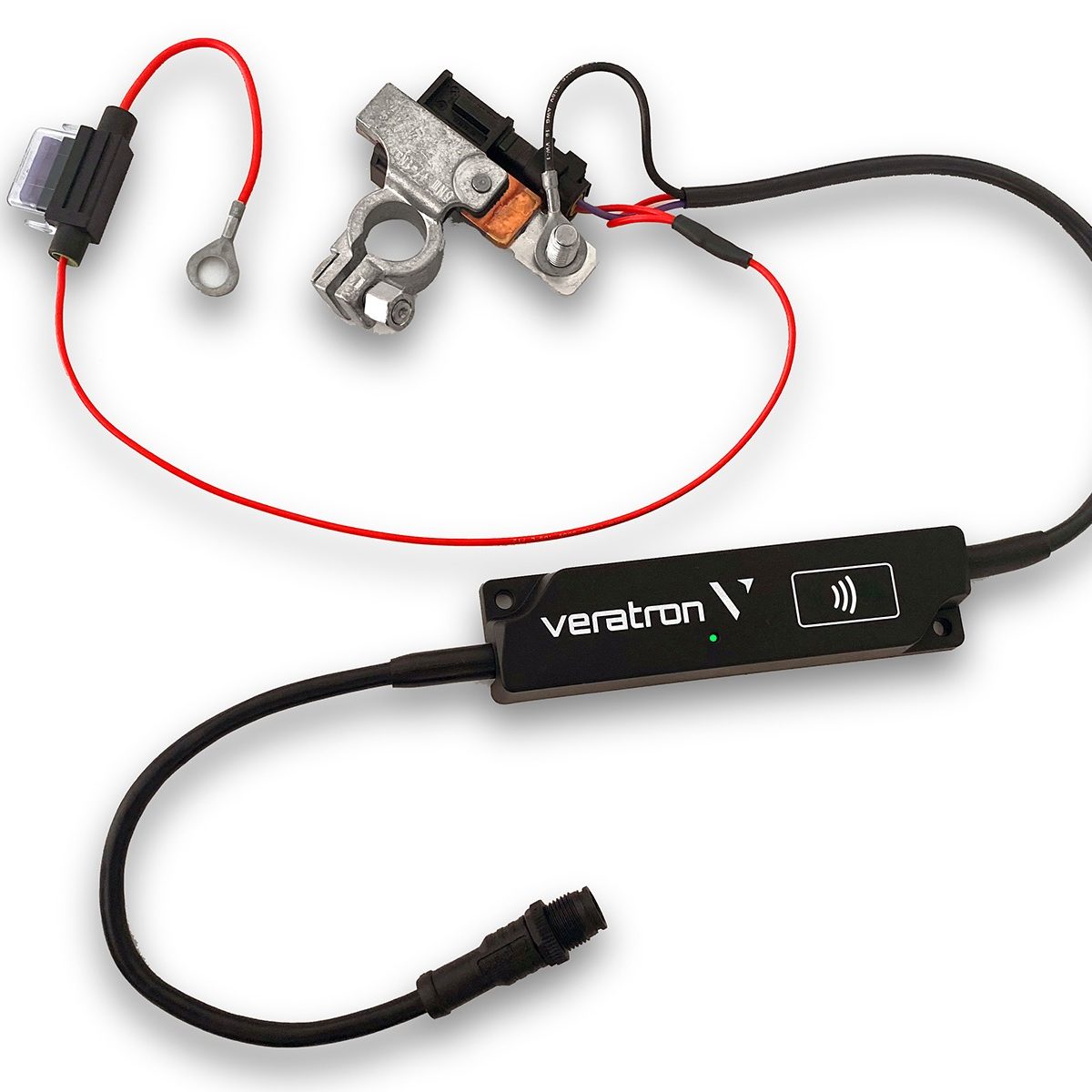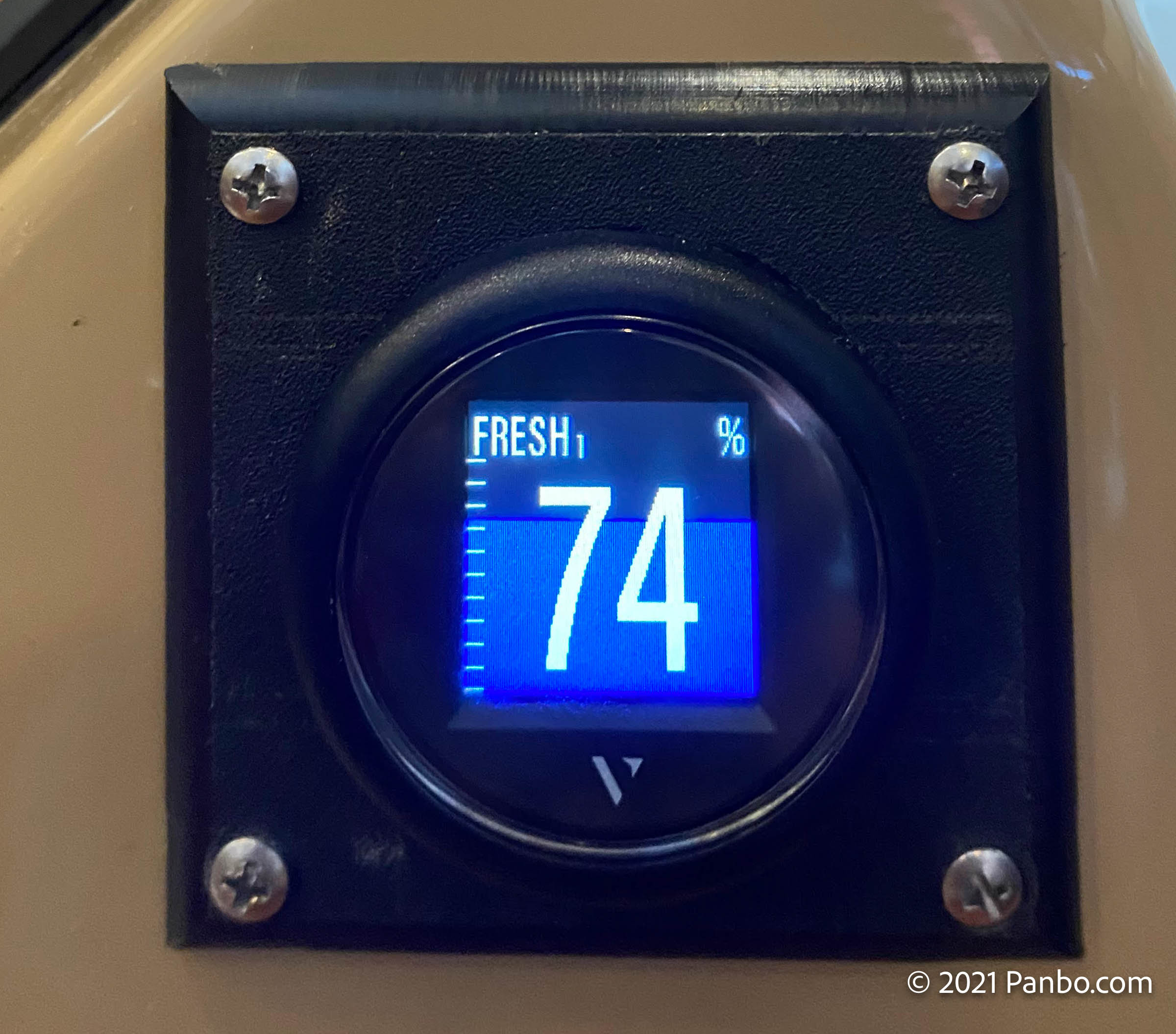Veratron LinkUp battery monitor, innovative configuration and NMEA 2000
Boaters have begun paying more attention to their batteries. Perhaps it’s because of the increased DC loads we place on them, or because of advanced battery technologies, or because of the significant investment that a properly sized bank can entail. And as boats have gotten more integrated, with MFDs often serving as the monitoring center for many systems, the demand for NMEA 2000 battery monitors has also increased. Veratron has introduced a battery monitor to meet these demands, and with it a very clever way of configuring the monitor that may ease the pain for builders, installers, and customers alike.
The Veratron Intelligent Battery Sensor (IBS) consists of two components: a battery post-top shunt and the LinkUP electronics module. The electronics module contains the NMEA 2000 circuitry, an NFC radio for configuration (more on that in a minute), and the interface to the shunt. The shunt itself is an automotive-style shunt designed for flooded, gel, and AGM lead-acid chemistry batteries. It’s limited to 250 amp-hours per battery and capable of 155 amps of sustained load, plus 1,500 amps for 500 milliseconds.
LinkUp configuration
Configuring NMEA 2000 sensors without a display from the same manufacturer can be challenging. Veratron answered this challenge in a very clever way that can make an installer or distributor’s life much easier. Each product in the LinkUp family (there are also tank level, J1939 engine converters, and a pressure and temperature sensor) is configured using near field communication or NFC — the same touchless technology used for Apple Pay, Android Pay, and similar systems. The modules are configured using Veratron’s LinkUP Configurator app on your phone.
Upon first launching the app you scan module with your phone. This scan (and writing a new configuration) can be done with the module installed and ready to go or powered off and sitting in the box. The idea that these can be easily and quickly configured without installing them or even powering them up strikes me as a big advantage for distributors and installers alike. It’s also just kind of cool that you can change the configuration without even turning it on.
Installation
I installed the IBS on the house bank of my RV, which consists of four GC2 golf cart batteries in a 2×2 parallel and series arrangement. This means that the four six-volt batteries effectively operate like two, 230 amp-hour, 12-volt batteries. So, to monitor these two batteries I needed two IBS since each 12v battery is 230 amp hours, nearly at the 250ah limit of the shunt. I’m the first to tell you I don’t like post-top shunts. Nearly every time I’ve installed them I find that they get in the way and require moving around large diameter cables that don’t like to move. I’ve also never loved that you have to buy and install one shunt per battery with the post-top shunts and this can become even more problematic with very large battery banks.
But during my installation, the post-top sensors revealed a problem I had completely missed with the batteries monitored by a Victron SmartShunt on the negative cable at the end of the battery string. That’s normal for boat battery banks, and means I only see the total current in and out of the string, not individual battery readings. But for reasons I haven’t yet discovered, one battery (or in this case, two 6v batteries effectively making a single battery) is supplying about two-thirds of the current while the second battery only supplies one-third. This is occurring regardless of the size of the load and while charging as well as discharging. I’ve ordered new, completely symmetrical length cables for both batteries to see if that’s the issue but the investigation remains open.
Without instrumenting each battery I never would have seen the issue. In the screenshot on the left above, Victron’s app shows what the SmartShunt is measuring. On the right, you can see a screenshot from a Yacht Devices WiFi gateway’s Web Gauges showing the data coming from both IBS shunts. The total readings are nearly identical and without the per-battery detail, one would assume that all is well. It wasn’t until I installed the Veratron sensors that I discovered the problem.
Every other battery monitor I’ve installed (except the SmartShunt and with those will likely still connect via VE.Direct) has come with its own display. Whether it’s a Victron BMV, a Balmar SG200 or something else, those displays come with another cable that has to be run. In contrast, many boats already have NMEA 2000 in the mechanical space where the batteries live. So, installation may be a lot easier if you already have your NMEA 2000 network close by. I’ve already run a NMEA 2000 network from one end of the RV to the other so I was able to easily add a few t-connectors to tap into it for the IBS install.
The IBS uses a Hella post-top battery sensor originally designed for automotive applications. This shunt measures voltage, current, state-of-charge, state-of-health, and temperature. The picture above shows VDO’s OceanLink Master 4.3-inch display showing all the battery’s data. Currently the firmware in the display shows each battery’s information individually but Veratron confirms they’re working on firmware that will show multiple batteries on the same screen. State-of-health takes some time to learn and from what I’ve been able to observe I don’t think the shunts have yet learned enough about my batteries to measure their health. I’ll report back in the comments when the shunts have enough data to make a determination.
There’s not a way to combine the data of multiple IBS into a single battery instance. So, if you have a larger battery bank of say eight batteries, you would have eight separate battery instances on your NMEA 2000 network. The information gleaned from each battery can be quite useful — as I learned on this installation — but displaying the data from all eight batteries is likely to be challenging. You could display the state of charge from one or two batteries and use that as an indicator of the state of the entire bank but there’s not an easy way to aggregate the data.
Opportunities for improvement
I think the IBS is pretty good already but I also did find some areas that could use some improvement. The first, and most noticeable to me is runtime calculations. In the screenshot above from a Raymarine Axiom connected to the IBS by NMEA 2000 you will see runtime calculations showing about 14 hours and 45 minutes remain for battery one. The trouble is, that’s to 0% SOC for the battery — and that’s a place you never want to take your batteries. Additionally, there’s not a way to initiate a manual synchronization of the sensor to tell it the batteries are fully charged. The IBS module is supposed to do this automatically but I’d like to be able to initiate that manually.
You may have noticed I haven’t included a link to Veratron’s website with information and downloads for the IBS. That’s because I haven’t been able to find any product info for LinkUp or the IBS on their site. I hoped for more info online, especially since the IBS comes with a bare-bones set of paper instructions.
Final thoughts
The Veratron IBS is, at least to this geek, a pretty exciting product. There aren’t many native NMEA 2000 battery monitors available right now so an easily configured and affordable NMEA 2000 battery monitor is worthy of note. The post-top shunt means that these monitors may be a better fit for vessels with smaller battery banks but also afford detailed, per-battery measurements. I’m looking forward to living with the monitors installed for a while and seeing what they decide about the health of my batteries. Plus, I plan to dig into the imbalance between the two battery sets, so keep your eyes peeled for an Ed Blog on my findings. In the meantime, I’m thrilled to see another solution that installs and configures easily and integrates seamlessly with my NMEA 2000 network.
























Ben, your cable connections are almost certainly the issue – assuming all the batteries are the same age and condition. If all the cables are not exactly the same length and gauge, and have uniformly solid connections at the posts, the “path of least resistance” principle will cause the uneven discharge yore seeing.
Thanks Grant, you’re quite right. I’ve changed both negative cables to be of identical length (and brand new terminations, etc). That seems to have resolved most, but not all of the issues. I haven’t changed the positive cables yet and there are quite a few more of them such that I’ll need to think about the options for those.
-Ben S.
“you’re”, not yore…. stupid spell-check!
This looks interesting, but it looks like it is not yet available. (at least I’ve been unable to find it). Any ideas from where this can be purchased?
I reached out to Veratron to see if they can provide some help on availability. I’ll let you know what I hear.
-Ben S.
I just heard back from Veratron. Lauderdale Speedometer, Common Ground, and AC DC Marine should all have units in stock. The LinkUp product line will also be carried by marine distributors and promoted for 2021. Lastly, Veratron themselves has them in stock and will sell direct for MSRP.
Hope that helps
-Ben S.
Thanks Ben. I appreciate the follow-up!
This might help – From the Veratron website:
https://www.veratron.com/dealers/
Thanks Grant, but I’ve tried everyone on their list who has a website. Half of those don’t have online ordering and none of them list this product.
Sounds like just the product I have been looking for!
Any indication of the end user price for the Veratron LinkUp?
I believe it carries a list price of $189. Lauderdale Speedometer has the resistive sensor version of the LinkUp for $99, I’d suggest calling them and seeing about the IBS version’s availability.
https://www.lspeedo.com/product/veratron-linkup-gateway-resistive-based-to-nmea2000-b00042201/
-Ben S.
Ben, now that you have been living with this for awhile, any additional thoughts?